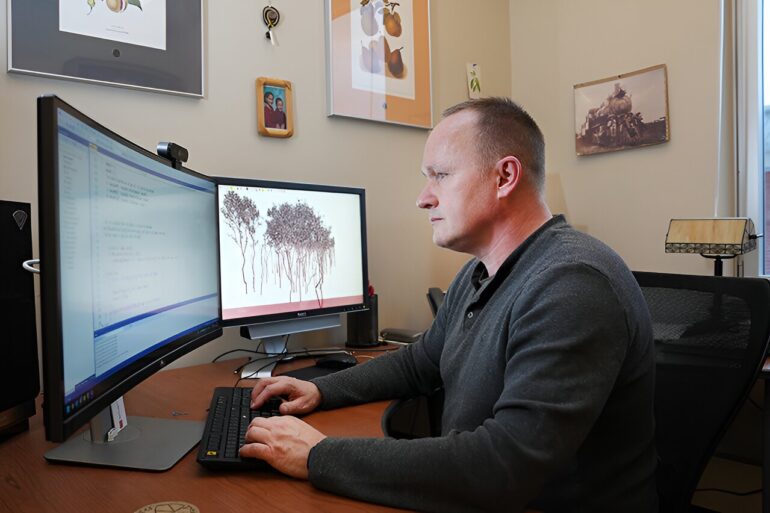TL;DR:
- Purdue University researchers and collaborators in Germany have developed AI models to simulate tree growth and shape.
- These models compress tree form data into a compact neural model, enabling the generation of detailed tree geometry.
- Deep learning techniques were employed to create growth models for various tree species.
- Traditional non-AI-based tree models are complex and require extensive simulation algorithms.
- The AI models promise to improve realism in fields such as architecture, urban planning, and entertainment.
- The research aims to bridge the gap between intrinsic tree properties and environmental responses.
- Challenges lie in obtaining real-world 3D tree geometry for training AI models.
Main AI News:
Artificial intelligence continues to revolutionize various fields, and now, it’s taking on the task of simulating tree growth and shaping in response to environmental factors. A groundbreaking research team, led by Purdue University’s Department of Computer Science in collaboration with Sören Pirk from Kiel University in Germany, has harnessed the power of AI to create advanced tree simulation models.
Drawing inspiration from the intricate encoding of DNA, Bedrich Benes, a distinguished professor of computer science, and his team have developed cutting-edge AI models that compactly encapsulate the information needed to define tree forms within a mere megabyte-sized neural model. Through rigorous training, these AI models can effectively encode the localized development of trees, producing detailed tree models with gigabytes of intricate geometry as their output.
In a remarkable achievement documented in two influential papers—one published in ACM Transactions on Graphics and the other in IEEE Transactions on Visualizations and Computer Graphics—Benes and his team elucidate their groundbreaking tree-simulation AI models. “The AI models learn from large datasets to mimic the intrinsic behavior discovered in nature,” Benes explains, highlighting the remarkable feat of AI-based simulation.
Traditionally, digital tree models have relied on complex, non-AI-based simulation algorithms, which account for numerous mutually influencing nonlinear factors. These models are indispensable in fields such as architecture, urban planning, and the gaming and entertainment industries, as they strive to create designs that captivate clients and audiences with heightened realism.
After almost a decade of working with AI models, Benes expected them to enhance the existing methods for digital tree replication. However, the size and complexity of the models came as a surprise. “It’s complex behavior, but it has been compressed into a relatively small amount of data,” he remarks, underscoring the efficiency of their approach.
The co-authors of the ACM Transactions on Graphics paper include Jae Joong Lee and Bosheng Li, Purdue graduate students in computer science. In the IEEE Transactions on Visualization and Computer Graphics paper, they are joined by Xiaochen Zhou, also a Purdue graduate student in computer science, Songlin Fei, the Dean’s Chair in Remote Sensing and director of the Institute for Digital Forestry, and Sören Pirk from Kiel University, Germany.
This groundbreaking research leveraged deep learning, a branch of AI, to generate growth models for various tree species, such as maple, oak, pine, walnut, and more, with or without leaves. Deep learning entails developing software that trains AI models to perform specific tasks, mimicking certain aspects of human brain functionality.
Benes notes, “Although AI has achieved significant success in modeling unrelated 3D geometries, particularly in computer-aided design and digital manufacturing, creating a 3D geometry model for vegetation has long remained a challenge.” While some approaches to simulating biological behaviors have improved, Benes and his team point out that readily available methods for swiftly generating 3D models of real trees are scarce.
Traditionally, experts with biological expertise have undertaken the task of simulating tree growth, as they possess an understanding of how trees interact with their environments. These interactions depend on the inherent characteristics encoded in the tree’s DNA, including branching angles and other attributes. Environmental conditions further influence the tree’s development, often resulting in distinct shapes for the same tree species under different conditions.
Deciphering the intricate relationship between a tree’s intrinsic properties and its response to the environment has proven to be a formidable challenge. Benes explains, “We looked at thousands of trees and thought, ‘Hey, let AI learn it.’ Maybe we can then distill the essence of tree form with AI.”
While scientists typically build models based on hypotheses and observations of nature, the researchers’ AI models generalize behavior from vast input data drawn from thousands of trees. Subsequently, they validate that these models faithfully replicate the behavior observed in the input data.
The primary limitation of these AI tree models is the absence of training data that describes real-world 3D tree geometry. Benes aspires to bridge this gap, envisioning a future where you can simply take a picture of a tree with your cellphone and instantly generate a 3D geometry representation inside a computer. “This is next, and it’s perfectly aligned with the mission of digital forestry,” he concludes, hinting at the exciting possibilities AI holds for the future of our forests and natural landscapes.
Conclusion:
The breakthrough in AI-driven tree simulation has the potential to revolutionize industries that rely on realistic digital representations of trees, including architecture, urban planning, and entertainment. The ability to generate intricate tree models from compact neural models is a significant advancement, offering new possibilities for design and visualization. However, challenges in obtaining real-world tree data remain, presenting opportunities for data acquisition solutions in the digital forestry market.

